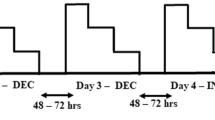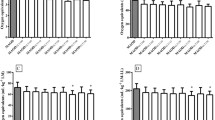Summary
This study examined the specificity of maximum aerobic power and the anaerobic threshold (AT) in 10 endurance-trained cyclists and 10 endurance-trained runners who performed continuous progressive work tests on the bicycle ergometer and treadmill.
Dependent ‘t’ tests for \(\dot V\)O2 max l/min−1 indicated that the cyclists scored higher on the bicycle ergometer (\(\bar X\)=4.5 l/min−1) than the treadmill (\(\bar X\)=4.34 l/min−1) but the difference was not statistically significant. By contrast, the runners fared significantly better (p<0.05) on the treadmill (\(\bar X\)=68.1 ml/kg·min−1) compared with the bicycle ergometer (\(\bar X\)=61.7 ml/kg·min−1).
When the AT was expressed as a percentage of \(\dot V\)O2 max, there were no significant differences between the cyclists (66.3%) and runners (61.2%) on the bicycle ergometer or the runners (77.3%) and cyclists (74.3%) on the treadmill. However, this tendency for the better score to be registered by the group tested on the activity for which it trained was most pronounced when the AT was expressed in l/min−1 and ml/kg·min−1·Independent ‘t’ tests accordingly indicated that the cyclists (3.0 l/min−1) had significantly (p<0.05) greater AT's than the runners (2.56 l/min−1) on the bicycle ergometer whereas the runners (52.7 ml/kg·min−1) had significantly (p<0.05) higher AT's than the cyclists (46.8 ml/kg·min−1) on the treadmill.
These data suggest that the adaptive responses to exercise are in part a function of the specific movement patterns executed in training. Thus, if \(\dot V\)O2 max and the AT are to be measured in the laboratory, the tests must allow optimal innervation of the specifically trained muscle fibres.
Similar content being viewed by others
References
Anderson P, Henricksson J (1977) Capillary supply of the quadriceps femoris muscle in man: adaptive response to exercise. J Physiol 270: 677–690
åstrand I (1967) Degree of strain during building work as related to individual aerobic work capacity. Ergonomics 10: 293–303
åstrand PO, Saltin B (1961) Maximal oxygen uptake and heart rate in various types of muscular activity. J Appl Physiol 16: 977–981
Brouha L (1945) Spécificité de l'entraÎnement au travail musculaire. Rev Canad Biol 4: 144–148
Clausen JP, Trap-Jensen J (1968) Effects of training on circulatory response to exercise. Acta Physiol Scand 74: 23 A (communication 18)
Clausen JP, Larsen OA, Trap-Jensen J (1969) Physical training in the management of coronary artery disease. Circulation 40: 143–154
Costill DL (1970) Metabolic responses during distance running. J Appl Physiol 28: 251–255
Costill DL, Jansson E, Gollnick PD, Saltin B (1974) Glycogen utilization in leg muscles of men during level and uphill running. Acta Physiol Scand 91: 475–481
Davis JA, Vodak P, Wilmore JH, Vodak J, Kurtz P (1976) Anaerobic threshold and maximal aerobic power for three modes of exercise. J Appl Physiol 41: 544–550
Davis JA, Frank MH, Whipp BJ, Wasserman K (1979) Anaerobic threshold alterations caused by endurance training in middle-aged men. J Appl Physiol 46: 1039–1046
Dill DB, Talbott JH, Edwards HT (1930) Studies in muscular activity. VI Response of several individuals to a fixed task. J Physiol 69: 267–305
Gollnick PD, Armstrong RB, Saltin B, Saubert C, Sembrowich W, Shepherd R (1973) Effect of training on enzyme activity and fiber composition of human skeletal muscle. J Appl Physiol 34: 107–111
Gutmann I, Wahlefield AW (1974) L-(+)-lactate determination with lactate dehydrogenase and NAD. In: Bergmayer HU (ed) Methods of enzymatic analysis, vol 3. Academic Press, New York, pp 1464–1468
Hagberg JM, Giese MD, Schneider RB (1978) Comparison of the three procedures for measuring \(\dot V\)O2 max in competitive cyclists. Eur J Appl Physiol 39: 47–52
Henriksson J, Bonde-Petersen F (1974) Integrated electromyography of quadriceps femoris muscle at different exercise intensities. J Appl Physiol 36: 218–220
Hermansen L, Hultman E, Saltin B (1967) Muscle glycogen during prolonged severe exercise. Acta Physiol Scand 71: 129–139
Holloszy JO, Rennie MJ, Hickson RC, Conlee RK, Hagberg JM (1977) Physiological consequences of the biochemical adaptations to endurance exercise. Ann NY Acad Sci 301: 440–450
Issekutz B Jr, Miller HI, Rodahl K (1966) Lipid and carbohydrate metabolism during exercise. Fed Proc 25: 1415–1420
Ivy JL, Withers RT, Van Handel PJ, Elger D, Costill D (1980) Muscle respiratory capacity and fiber type as determinants of the lactate threshold. J Appl Physiol: Respirat Environ Exerc Physiol 48: 523–527
Jorfeldt L (1971) Turnover of 14C-L(+)-lactate in human skeletal muscle during exercise. In: Pernow B, Saltin B (eds) Muscle metabolism during exercise. Plenum Press, New York, pp 409–417
Katch V, Weltman A, Sady S, Freedson P (1978) Validity of the relative percent concept for equating training intensity. Eur J Appl Physiol 39: 219–227
Keppel G (1973) Design and analysis: a researcher's handbook. Prentice-Hall, Englewood Cliffs New Jersey
Kindermann W, Simon G, Keul J (1979) The significance of the aerobic-anaerobic transition for the determination of work load intensities during endurance training. Eur J Appl Physiol 42: 25–34
Margaria R, Edwards HT, Dill DB (1933) The possible mechanisms of contracting and paying the oxygen debt and the role of lactic acid in muscular contraction. J Appl Physiol 106: 689–715
Matsui H, Kitamura K, Miyamura M (1978) Oxygen uptake and blood flow of the lower limb in maximal treadmill and bicycle exercise. Eur J Appl Physiol 40: 57–62
McArdle WD, Magel JR (1970) Physical work capacity and maximal oxygen uptake in treadmill and bicycle exercise. Med Sci Sports 2: 118–123
McArdle WD, Katch FI, Pechar GS (1973) Comparison of continuous and discontinuous treadmill and bicycle tests for max \(\dot V\)O2. Med Sci Sports 5: 156–160
Morgan TE, Cobb LA, Short FA, Ross R, Gun DR (1971) Effects of long-term exercise on human muscle mitochondria. In: Pernow B, Saltin B (eds) Muscle metabolism during exercise. Plenum Press, New York, pp 87–95
Pechar GS, McArdle WD, Katch FI, Magel JR, Deluca J (1974) Specificity of cardiorespiratory adaptation to bicycle and treadmill training. J Appl Physiol 36: 753–756
Rennie MJ, Winder WW, Holloszy JO (1976) A sparing effect of increased plasma fatty acids on muscle and liver glycogen content in the exercising rat. Biochem J 156: 647–655
Rennie MJ, Holloszy JO (1977) Inhibition of glucose uptake and glycogenolysis by availability of oleate in well-oxygenated perfused skeletal muscle. Biochem J 168: 161–170
Robinson S, Harmon PM (1941) The lactic acid mechanism and certain properties of the blood in relation to training. Am J Physiol 132: 757–769
Saltin B, Hartley LH, Kilbom å, åstrand I (1969) Physical training in sedentary middle-aged and older men. II. Oxygen uptake, heart rate and blood lactate concentration at submaximal and maximal exercise. Scand J Clin Lab Invest 24: 323–334
Saltin B, Karlsson J (1971) Muscle glycogen utilization during work of different intensities. In: Pernow B, Saltin B (eds) Muscle metabolism during exercise. Plenum Press, New York, pp 289–299
Varnauskas E, Bjorntorp P, Fahlén M, PŘerovský I, Stenberg J (1970) Effects of physical training on exercise blood flow and enzymatic activity in skeletal muscle. Cardiovasc Res 4: 418–422
Weltman A, Katch V, Sady S, Freedson P (1978) Onset of metabolic acidosis (anaerobic threshold) as a criterion measure of submaximal fitness. Res Quart 49: 218–227
Williams CG, Wyndham CH, Kok R, von Rahden MJE (1967) Effect of training on maximum oxygen uptake and on anaerobic metabolism in man. Int Z Angew Physiol 24: 18–23
Wilmore JH, Costill DL (1974) Semiautomated systems approach to the assessment of oxygen uptake during exercise. J Appl Physiol 36: 618–620
Wiswell RA, Girandola RN, de Vries HA (1979) Comparison of anaerobic threshold on bicycle and treadmill. Med Sci Sports 11: 88
Withers RT (1977) Anaerobic work at submaximal relative workloads in subjects of high and medium fitness. J Sports Med Phys Fitness 17: 17–24
Author information
Authors and Affiliations
Rights and permissions
About this article
Cite this article
Withers, R.T., Sherman, W.M., Miller, J.M. et al. Specificity of the anaerobic threshold in endurance trained cyclists and runners. Europ. J. Appl. Physiol. 47, 93–104 (1981). https://doi.org/10.1007/BF00422487
Accepted:
Issue Date:
DOI: https://doi.org/10.1007/BF00422487




